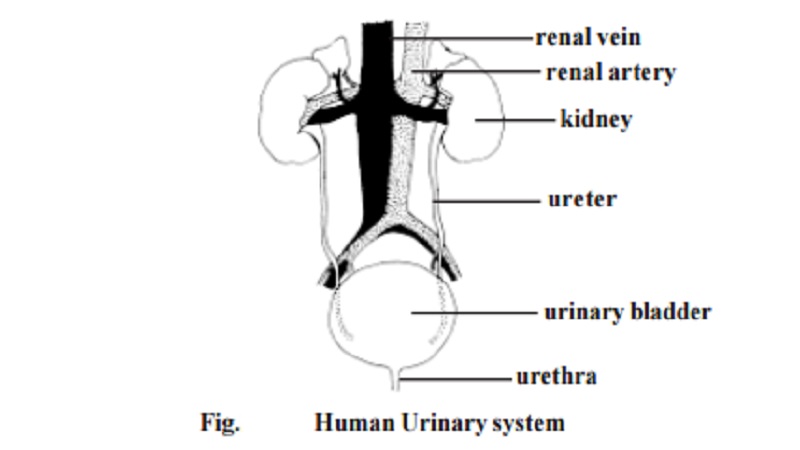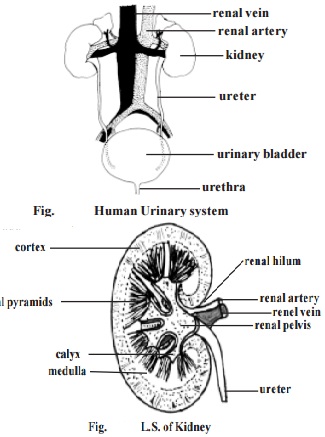Chapter: BIOLOGY (ZOOLOGY) Standard XI first year 11th text book Assignment topics question and answer Explanation Definition
Urinary system : kidneys (renes), ureters, the uri-nary bladder (vesica urinaria) and the urethra

Urinary system : kidneys (renes), ureters, the uri-nary bladder (vesica urinaria) and the urethra
Urinary system
It is customary to link the organs of urinary excretion and reproduc-tion as urino-genital system. The suitability of this concept is questionable.
The urinary and reproductive organs differ in their embryological origin and development. In postnatal human beings, the association between the compo-nents of the urinary and the reproductive systems is very much limited. Hence the urinary and reproductive systems are considered separately.
The urinary organs comprise, two kidneys (renes), ureters, the uri-nary bladder (vesica urinaria) and the urethra.
The kidneys.

The kidneys are bean shaped organs. In fresh state the kidneys are reddish brown in colour. They lie on the posterior abdominal wall. In the abdomen, the right kidney is slightly lower than the left. It is because of the presence of liver superior to it. The kidneys are surrounded by adipose tissue. Each kidney is about 11 cm in length, 6cm in breadth and 3cm in antero-posterior dimensions. In adult males the average weight of kidney is about 150g (in adult female 135g).
The inner margin of each kidney has a small depression called the hilum. The renal artery and nerves enter and the renal vein and the ureter exit at this region. The hilum opens into a cavity called the renal sinus.
Each kidney is enclosed by a fibrous connective tissue layer, called the renal capsule. Internally the kidney is divided into an outer cortex and an inner medulla . The medulla consists of several cone - shaped renal pyramids. Extensions of the pyramids called the medullary rays, project from the pyramids into the cortex. Extension of the cortex called renal col-umns, project between the pyramids. The tips of the pyramids are called the renal papillae. They are pointed toward the renal sinus. The renal papillae are surrounded by funnel shaped structures called the minor calyces. The minor calyces of several pyramids join together to form larger funnels called major calyces. There are 8-20 minor calyces and 2 or 3 major calyces per kidney. The major calyces converge to form an enlarged channel called the renal pelvis. The renal pelvis then narrows to form the ureter. The ureter leaves the kidney and gets connected to the urinary bladder.
Nephron.
The basic functional unit of each kidney is the nephron. There are approximately 1.3 million nephrons in each kidney. Atleast 450,000 of them must remain functional to ensure survival. Each nephron consists of an en-larged terminal end called the renal corpuscle, a proximal tubule, a loop ofHenle and a distal tubule. The distal tubule opens into a collecting duct. The renal corpuscle, proximal tubule and distal tubules are in the renal cortex. The collecting tubules and parts of the loops of Henle enter the renal medulla.

Most nephrons measure 50-55 mm in length. 15% of the nephrons are larger and they remain near the medulla. These are called thejuxtamedullary nephrons. They have larger loops of Henle.
The renal corpuscle of the nephron consists of a Bowman's capsule and a bunch of capillaries called the glomerulus.
In the Bowman's capsule the outer and inner layers are called pari-etal and visceral layers respectively. The outer parietal layer is composed ofsimple squamous epithelium. The inner visceral layer surrounds the glomeru-lus. It consists of specialized cells called podocytes. The walls of the glom-erular capillaries are lined with endothelial cells. There is a basement membrane between the endothelial cells of the glomerular capillaries and the podocytes of Bowman's capsule. The capillary endothelium, the basement membrane and the podocytes of Bowman's capsule make up the filtrationmembrane.
The glomerulus is supplied with blood by an afferent arteriole. It is drained by an efferent arteriole.
The cavity of Bowman's capsule opens into the proximal tubule. The proximal tubule is also called the proximal convoluted tubule. It is approxi-mately 14mm long and 60 �m in diameter.
Posteriorly the proximal tubule continues as the loop of Henle. Each loop has a descending limb and an ascending limb. The first part of the de-scending limb is similar in structure to the proximal tubule. The loops of Henle that extend into the medulla become very thin near the end of the loop. The first part of the ascending limb is also very thin and it consists of simple squa-mous epithelium, but it soon becoms thick. The distal tubules, also called the distal convoluted tubules are not as long as the proximal tubules.
Ureters and Urinary bladder
The ureters extend inferiorly from the renal pelvis. They arise medi-ally at the renal hilum to reach the urinary bladder. The bladder is meant for temporarily storing the urine. The urinary bladder is a hollow muscular bag. It lies in the pelvic cavity. The size of the bladder depends on the presence or absence of urine. The bladder capacity varies from 120-320ml. Filling upto 500 ml is tolerated. Micturition will occur at 280ml. The ureters enter the bladder inferiorly on its posterolateral surface. The urethra exits the bladder inferiorly and anteriorly. At the junction of the urethra with the urinary bladder smooth muscles of the bladder form the internal urinary sphincter. Around the urethra there is another external urinary sphincter. The sphincters control the flow of urine through the urethra.
In the male the urethra extends to the end of the penis where it opens to the outside. In male the urethra is 18-20cm long. In the female the urethra is shorter. It is about 4 cm long and 6 mm in diameter.
Related Topics